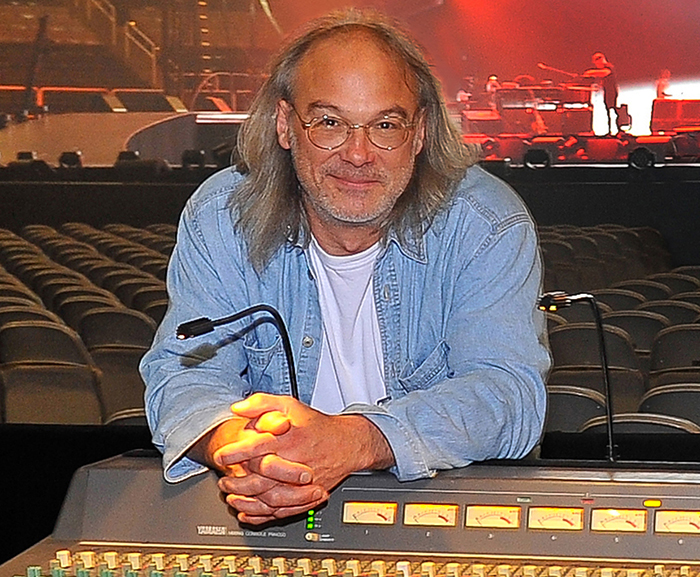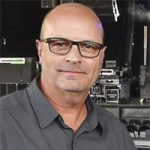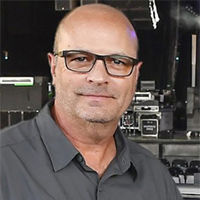In the midst of the Coronavirus quarantine, I decided to begin a series of interviews with some of the live audio industry’s most recognizable, influential and often notorious sound engineers. I put a short list together very quickly of some well-known mixers that I admire and respect, and who have influenced many others throughout the years with their approach, techniques and willingness to share their knowledge.
Some of the names on my short list are people I’ve worked with or become friends with over the years. Others I have yet to meet in person, although I’ve really wanted to.
My first interview is with Dave Natale (who happened to be the first name that popped to mind when I was asked about doing this). Dave is a long-time, legendary front of house mixer, most recently pushing faders for The Rolling Stones. Dave spent many years mixing Tina Turner and many other great artists. When I first heard his name in 1991, he had just finished up some time at the helm for Van Halen, and he’s also mixed Joe Cocker, Lionel Ritchie, Stevie Nicks, Yes and many others.
We spent almost a month together this past February prepping for the Super Bowl halftime show. Dave mixed the stadium FOH audio for the performance by Jennifer Lopez and Shakira. I was there to assist him with rehearsals but also ended up making a new friend. We spent those weeks talking audio, consoles, plugins and life, even finding time to watch a YouTube video or two about steel machining. Who knew? Here’s a glimpse of some of the dialog we shared then and recently.
Jim Yakabuski: Dave, it’s an honor to have you involved with this. I’ll start by asking: When did you start working in audio?
Dave Natale: I’m not sure of the exact date but if I had to guess I would say about 1975.
JY: Nice! You beat me to it by about six years. What inspired you to want to be an audio engineer?
DN: I was playing drums for a band and they wanted to play material that I was not really into, so I found them a drummer and told them that I would do the sound.
JY: Another “musician gone to the audio side” story. There are lots of those in our industry for sure. Would you consider yourself more of a “music-based” mixer or a “technically-based” engineer? If both, how would you say you combine both sides when mixing a band?
DN: I would have to say that I’m a music-based mixer; however, if I have to get technical I can, but prefer not to be.
JY: This next question is a big, fat, slow-pitched softball coming your way. It’s pretty much rhetorical as many of us may already know the answer, but I’ll ask it anyway and get your take: Do you prefer analog or digital mixing consoles? If your answer is “analog,” what reasons drive you to continue using analog in today’s audio world and why not just switch to digital?
DN: Analog – definitely. For me, analog is far more reliable than digital. I have to use digital consoles when I mix TV shows or special events that have multiple bands, and I see digital consoles seize up for any number of reasons way more frequently than my analog consoles ever have. If an analog console gives you a problem, nine times out of 10 it’s the power supply. I always carry a spare or three so I just change that out.
If there’s a problem with one input or output channel I just pull it out and replace it with a spare. No problem. I’ve used a Yamaha PM4000 for every tour that I’ve mixed since at least 1996 and can’t remember the last time that I had a problem with either an input of output channel or module, and I can say for sure that I’ve never had a power supply issue once in that entire time.
JY: We chatted a lot about life and the industry while we spent a few weeks in Miami for the Super Bowl. From one older audio person to another: What’s the toughest thing about continuing as a touring audio engineer these days (and at a more advanced age)?
DN: For me, I simply like being at my house with my wife. I’ve spent so many days/weeks/months on the road over the past 40 years that I am, for lack of a better term, over-traveled.
JY: A lot has changed since you started in 1975. It was analog consoles for all of us, and racks of processing gear instead of plugins. What would you say is your favorite piece of audio gear that you’ve used in your career?
DN: I don’t use any outboard gear, if possible. For example, with The Stones I don’t use any gates, limiters or effects, so that only leaves the console. So, I guess that it would be the PM4000.
JY: This next question should just be struck from the record, but I have to ask: Plugins, no plugins, or just a few plugins?
DN: I use plugins — I plug all of the microphones into the back of the console every day. So I guess the answer is that I use one “plug in” per channel.
JY: Keeping with the theme of old versus new: What’s better about today’s PA/loudspeaker systems?
DN: With modern line arrays the band is free to perform wherever they want. Almost all bands have a runway and/or a “B” stage, and with a line array I have no problem with feedback when they are in front of the PA while keeping it “stadium loud.”
With The Stones, Mick Jagger will stand as far as 120 feet in front of the PA during the show and at certain times the four principals are all playing out there, as well. On the first tour I did with them – A Bigger Bang – the PA actually hung 25 feet upstage of the entire band when they were on the main stage!
The newer systems weigh less than the older systems and there are less cabinets to deal with. Further to that point I still use Clair I5 cabinets because they utilize 18-inch speakers for the low end I don’t find a need to use subs. That saves a bunch of extra cabinets, amps and truck space as well.
JY: Let’s keep the questions fair and balanced: What did you like better about the older sound systems?
DN: The sheer number of drivers. I used to use 144 Clair Brothers S-4 cabinets for outdoor gigs. Each one had two 18-inch speakers so that was 288 18-inch speakers. When the drummer hit the kick drum you felt it!
JY: The modern FOH setup has a lot of computers performing an array of tasks ranging from loudspeaker system management to frequency analysis and multitrack recording and playback. Do you like to personally use measurement tools and software, or do you prefer the system engineer to get the system “ready for line check”?
DN: Nowadays with the PA systems being the way that they are, you’re pretty much at the mercy of the person that sets it up and tunes it. I know a lot of mixers that can do it all themselves – I’m not one of those people. When I’m mixing a band and it is our tour, I have the system engineer set the system up and then I ruin that person’s fine work with a pair of third-octave EQs.
JY: Alright, let’s dig in a bit deeper. We spoke a lot about this in Miami and shared several common opinions. I’m going to ask you to step out of your comfort zone a bit with this one: What “trends” are you seeing in music and audio that you would like to see go away?















